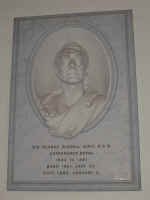
|
|
|
|
| Need some sun? |
 |
|
| Stressful life? |
|

|
|
For relief
|
|
Travelling to Europe?
Hotel, theater deals
|
|
|
| |
| |
|
|
Sir George Biddell Airy K.C.B., M.A., LL.D., D.C.L., F.R.S., F.R.A.S.
Seventh Astronomer Royal
 Born: 27 July 1801 at Alnwick, Northumberland, England Born: 27 July 1801 at Alnwick, Northumberland, England
Died: 2 Jan 1892 at Greenwich, England
Buried: Playford Church, Suffolk, England
Astronomer Royal: 1835 - 1881
Key events:
1819 - Sizar of Trinity College, Cambridge, England
1823 - Senior wrangler (the top First Class student) and first Smith's prizeman
1824 - Fellow of Trinity College, Cambridge, England
1826 - Appointed Lucasian Professor of Mathematics at Cambridge University, England
1826 - Published Mathematical Tracts on Physical Astronomy - Become a standard work
1828 - Appointed Plumian Professor of Astronomy at Cambridge & Director of the Cambridge Observatory
1828 - Member of Astronomical Society
1829 - Member of Geological Society
1834 - Appointed chairman of the Commission set up to construct Standard Weights & Measures
1835 - Appointed as seventh Astronomer Royal
1836 - Elected a Fellow of the Royal Society (FRS)
1838 - Equipped Royal Observatory. Created magnetic and meteorological department at Greenwich
1838 - reduced all planetary & lunar observations at Greenwich from 1750 - 1830
1840 - Presented the Bakerian lecture to the Royal Society entitled On the theoretical explanation of an apparent new polarity of light
1844 - Awarded Doctorate (DCL) of Oxford University
1846 - Gold medallist Royal Astronomical Society
1846 - 13 November : Meeting of Royal Astronomical Society on the and the contributions of , Challis and were published
1847 - Erected the Alt-azimuth (used to calculate the Moon's altitude & azimuth)
1848 - Invented photographic registration
1850 - Built “Transit Circle” telescope in the Greenwich Observatory’s Meridian Building.
The cross-hairs in the eyepiece of the Transit Circle precisely defined Longitude 0° for the world. This is the precise point from which World Time and World Maps are measured. As the earth’s crust is moving very slightly all the time the exact position of the Prime Meridian is now moving very slightly too, but the original reference for the prime meridian of the world remains the Airy Transit Circle in the Greenwich Royal Observatory, even if the exact location of the line may move to either side of Airy’s meridian.
1851 - Elected President of the British Association
1854 - Invented transits timed by electricity
1862 - Awarded Doctorate (LL.D.) of Cambridge University
1868 - Spectroscopic observations
1871 - Elected President of the Royal Society of London holding the post for two years
1872 - Awarded KCB - Edinburgh University
1872 - Knighted by Queen Victoria (having declined the offer on three previous occasions)
1873 - Daily round of sunspot using Kew heliograph
1874 - Controlled British expeditions to observe the transit of Venus
1880 - Greenwich Mean Time adopted as legal time in Britain
1881 - Retired as Astronomer Royal
1892 - Died at Greenwich, England
1892 - Buried at Playford, Suffolk, England
"On September 15, 1842, the British Astronomer Royal, Sir George Biddell Airy, K.C.B., M.A., LL.D., D.C.L., F.R.S., F.R.A.S., responded to a query from the Chancellor of the Exchequer. The Government was considering funding an invention of one Charles Babbage. Should Parliament support the construction of the analytical engine (the first mechanical calculator and predecessor to digital computers?) What would be the value of such a device?
The learned astronomer's one-word reply: 'Worthless.'"
Quote from : Silicon Snake Oil : Second Thoughts on the Information Highway by Clifford Stoll
He was born on July 27, 1801 in Alnwick, Northumberland, England and died on January 2, 1892 in Greenwich, London. He is buried in Playford Church in Suffolk. He was not only the seventh Astronomer Royal (1835-81) but was also a very versatile scientist.
He reorganized the Royal Greenwich Observatory, installed new apparatus, including the telescope that defines the Greenwich Meridian, and rescued thousands of observations from oblivion. He did, however, hesitate in acting on the calculations of English astronomer John C. Adams in 1845 and delayed the discovery of Neptune. Airy improved the theory of the orbital motions of Venus and of the Moon, and in 1871 he used a water-filled telescope to test the effect of the Earth's motion on the aberration of light. In 1838 he devised a compass-correction system for the Royal Navy.
Airy in 1827 was the first to attempt to correct astigmatism in the human eye (his own) by use of a cylindrical eyeglass lens. He contributed also, in optics, to the study of interference fringes and to the mathematical theory of rainbows. The Airy disk, the central spot of light in the diffraction pattern of a point light source, is named after him.
In 1854 he measured gravity by swinging the same pendulum at the top and bottom of a deep mine and thus computed the density of the Earth. He was among the first to propose (c. 1855) the theory that root structures of lower density must exist under mountains to maintain isostatic equilibrium. Airy was knighted in 1872.
Other relevant websites:
- (8 books/articles)
- - by Bob Bruen
- (and Airy)
|
|
|